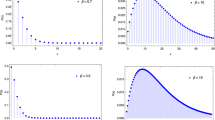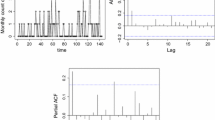Abstract
In this paper, we construct a new mixture of geometric INAR(1) process for modeling over-dispersed count time series data, in particular data consisting of large number of zeros and ones. For some real data sets, the existing INAR(1) processes do not fit well, e.g., the geometric INAR(1) process overestimates the number of zero observations and underestimates the one observations, whereas Poisson INAR(1) process underestimates the zero observations and overestimates the one observations. Furthermore, for heavy tails, the PINAR(1) process performs poorly in the tail part. The existing zero-inflated Poisson INAR(1) and compound Poisson INAR(1) processes have the same kind of limitations. In order to remove this problem of under-fitting at one point and over-fitting at others points, we add some extra probability at one in the geometric INAR(1) process and build a new mixture of geometric INAR(1) process. Surprisingly, for some real data sets, it removes the problem of under and over-fitting over all the observations up to a significant extent. We then study the stationarity and ergodicity of the proposed process. Different methods of parameter estimation, namely the Yule-Walker and the quasi-maximum likelihood estimation procedures are discussed and illustrated using some simulation experiments. Furthermore, we discuss the future prediction along with some different forecasting accuracy measures. Two real data sets are analyzed to illustrate the effective use of the proposed model.




Similar content being viewed by others
References
Al-Osh M, Alzaid AA (1987) First-order integer-valued autoregressive (INAR(1)) process. J Time Ser Anal 8(3):261–275
Barreto-Souza W (2015) Zero-modified geometric INAR(1) process for modelling count time series with deflation or inflation of zeros. J Time Ser Anal 36:839–852
Freeland RK, McCabe B (2005) Asymptotic properties of CLS estimators in the Poisson AR(1) model. Stat Probab Lett 73(2):147–153
Freeland RK, McCabe BP (2004) Forecasting discrete valued low count time series. Int J Forecast 20(3):427–434
Jazi MA, Jones G, Lai CD (2012) First-order integer valued AR processes with zero inflated Poisson innovations. J Time Ser Anal 33(6):954–963
Latour A (1998) Existence and stochastic structure of a non-negative integer-valued autoregressive process. J Time Ser Anal 19(4):439–455
Maiti R, Biswas A, Das S (2015) Time series of zero-inflated counts and their coherent forecasting. J Forecast 34(8):694–707
McCabe B, Martin GM (2005) Bayesian predictions of low count time series. Int J Forecast 21(2):315–330
McKenzie E (1985) Some simple models for discrete variate time series. JAWRA J Am W Resour Assoc 21(4):645–650
McKenzie E (1986) Autoregressive moving-average processes with negative-binomial and geometric marginal distributions. Adv Appl Probab 18:679–705
Ristić MM, Bakouch HS, Nastić AS (2009) A new geometric first-order integer-valued autoregressive (NGINAR(1)) process. J Stat Plan Inference 139(7):2218–2226
Schweer S, Weiß CH (2014) Compound Poisson INAR(1) processes: stochastic properties and testing for overdispersion. Comput Stat Data Anal 77:267–284
Scotto MG, Weiß CH, Gouveia S (2015) Thinning-based models in the analysis of integer-valued time series: a review. Stat Model 15(6):590–618
Silva N, Pereira I, Silva ME (2009) Forecasting in INAR(1) model. REVSTAT-Stat J 7(1):119–134
Steutel F, Van Harn K (1979) Discrete analogues of self-decomposability and stability. Ann Probab 7:893–899
Weiß CH (2008) Thinning operations for modeling time series of counts-a survey. AStA Adv Stat Anal 92(3):319–341
Zeger SL (1988) A regression model for time series of counts. Biometrika 75(4):621–629
Acknowledgements
The authors would like to thank the reviewer and the associate editor for their careful reading and constructive suggestions which led to this improved version of the paper.
Author information
Authors and Affiliations
Corresponding author
Rights and permissions
About this article
Cite this article
Maiti, R., Biswas, A. & Chakraborty, B. Modelling of low count heavy tailed time series data consisting large number of zeros and ones. Stat Methods Appl 27, 407–435 (2018). https://doi.org/10.1007/s10260-017-0413-z
Accepted:
Published:
Issue Date:
DOI: https://doi.org/10.1007/s10260-017-0413-z




